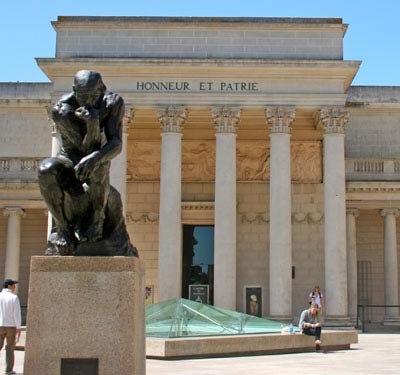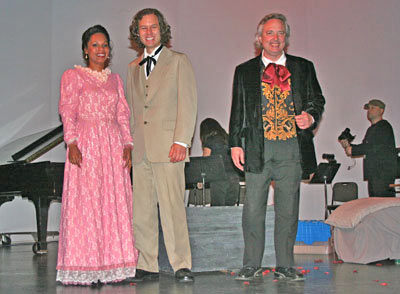San Francisco Splash Operanut is at it again; this time a weekend of one opera by two companies.
SUMMER IS HERE
According to an ancient proverb,
“One Swallow Doesn’t Make a Summer”
By logical implication,
Two swallows do make a summer.
This weekend l attended two different productions of Puccini’s La Rondine (The Swallow)
Ergo: Summer is here.
Two years ago, I did not know that La Rondine existed but I found out when I attended HD productions of it from the Met and Teatro la Fenice, and so I was looking forward to attending two live performances in one weekend.
Written at the beginning of World War I, La Rondine is one of Puccini’s last operas, and certainly his lightest opera. The story reminds me of La Traviata (speaking of which, my next assignment is in Palo Alto on May 21 when West Bay Opera will present that Verdi masterpiece). Both plots involve a glamorous lady of ill-repute giving up her life of luxury in favor of true love-at-first-sight. The couple spends an idyllic couple of months together in bucolic isolation, only to have the lady’s unsavory past catch up to them with tragic consequences.
But the differences are greater than the similarities. Alfredo knows what he’s getting into; Ruggero does not even know Magda’s true name. Violetta has consumption and will die within a year; Magda is in perfect health and has decades more to live. Violetta’s idyll is ended by Germont, Alfredo’s smug, hypocritic, sexist father (whom I hate more than I do villains like Iago and Scarpia who are honestly evil); Magda’s by her own conscience when called upon to face Ruggero’s mother. Finally, Puccini has the dramatic sense to end his story with the parting, leaving it to each member of the audience to balance the beauty and the tragedy; Verdi takes us through Act III to pretty much destroy the beauty, and Act IV with its memorable tragic death scene.
Saturday, April 28th dawned bright and clear, all set to justify the weather prediction (summer). By 11 am I was on my way with my two passengers: Barbara whom I had met at church a couple of years ago, and Cate, a sophomore at Stanford who assists in turning my personal prose into a properly formatted SPLASH review and who is responsible for many of the pictures you see here. We took the familiar scenic route: Interstate 280, California 35, Great Highway along the ocean, past Cliff House and Louis’ historic restaurant, and along Clement St. to Lincoln Park. Left my friends at the front door, parked the car (the one drawback to the Legion of Honor is parking; there’s always a space, but sometimes it’s a long up-hill walk up to get back – today it was only a short one), and by noon we were seated at the museum’s charming cafeteria.
After lunch I distributed our three tickets, and we toured the museum independently. Two o’clock found us in our front-row center seats, and a few minutes later Donald Pippin was delivering his inimitable monologue describing the Act I characters and plot. We were off!
Puccini’s style was apparent to me in the overture, but I also found myself reminded of Viennese Operetta and even of Broadway! (How an eight-piece string and woodwind ensemble plus piano can produce a “brassy” impression is beyond me – but then I’m used to Donald Pippin performing miracles). Once the opera starts, the perfect blend of music, words, and action is everything that one expects of Puccini.
Leslie Sandefur’s Magda was wonderful. Her singing was excellent and I could clearly see the play of emotion on her expressive face as she sang.
The comic duo of Michael Mendelsohn’s Prunier, the poet, and Elizabeth Russ’ parlor maid Lisette almost stole the show when they were on stage. She was delightfully pert and saucy, and he – well I think Michael is one of the great singing comics I’ve had the pleasure of hearing and seeing, and this role fit him perfectly.
To cap a perfect day, we stopped at Louis’ on the way home, and I introduced my companions to the fantastic view and the excellent hamburgers.
It is a fascinating experience to witness two different performances of the same opera on two consecutive days. So much is different – so much is the same. The music, the story, the characters, even the running time, are all the same. The director, the cast, the costumes, the scenery, the lighting, and the audience are all different; the fact that one performance is seen after the other is an important difference; and this weekend, the scale was different, and the language was different.
One ingredient, which can be very different, was in this case essentially the same: the director’s vision. Both PO’s Jane Hammet and OSJ’s Jose Maria Condemi focused on the emotional life of Magda – the dilemma she faced and the spirit in which she resolved it. Rergardless of the difference in our gender, I identified with Magda, not with any of the male characters. As Magda, I can recall both matinees as the same person. No schizophrenia here.
Almost all other Italian operas can be classified as either tragedies in which the heroine and/or hero die in the last scene, or comedies in which they live-happily-ever-after. La Rondine does not fit either category. No one dies, but ending is separation, not union. As I applaud the performance, my immediate feeling is sadness – why could the idyll not continue forever? But almost immediately I realize that it couldn’t; it was indeed an idyll, not reality. I begin to feel joy – a quiet happiness that such things could be. I think of Alfred Lord Tennyson’s poem In Memoriam: 27
I hold it true, whate’er befall;
I feel it, when I sorrow most;
‘Tis better to have loved and lost
Than never to have loved at all.
Well, time for me to return to reality and talk about some of the differences between the two performances – what they are and what I like about each.
1. The most obvious difference is scale:
Seats in Theater
Orchestra
Cast of listed roles
Additional chorus, supers, dancers
Three Hundred sixteen
Nine
Thirteen
Zero
Eleven hundred
Thirty seven
Thirteen
Thirty three
There are pros and cons to each size. Obviously you can get more sound variety from a 37-instrument orchestra including 21 strings and 5 brass than from 9 instruments including 4 strings and 0 brass. Likewise from a chorus of 33 vs one of 8. But there is only 1 Magda! There are many young singers whose tone, range, timber, pitch, etc. are every bit as good as the great Met stars but who lack the volume. Such a voice could give a brilliant performance at Florence Gould, might be barely adequate in California, and would be a disaster in War Memorial. Thus OSJ has a smaller pool of talent than PO and may have to settle for slightly less vocal quality or acting ability in order to be sure of adequate volume.
Then there’s the question of how close you are to the action. Even in the front row of seats in the California Theater you are separated from the front of the stage by a considerable amount of orchestra pit; and by much more to the back of the much larger stage. And, of course, since there are more than 3 times as many seats, the furthest seats will be even further away.
So, you “pays yer money and you takes yer choice.” The great thing about being an opera lover in the Bay area is that I don’t have to make a choice. I can have both.
2. A second big difference is scenery. PO has no backdrops or walls and minimal furnishings. OSJ has elaborate backdrops, walls, and furnishings – totally different for each of the 3 Acts. No question here – good scenery is a plus, and OSJ’s scenery was better than good – it was outstanding.
Was the scenery difference important to my enjoyment of the opera? The PO stage is small to start with, and the entire back half is occupied by the orchestra and piano. It would be hard to have much scenery without making the stage appear cluttered or even claustrophobic. While watching the opera I am not in the least conscious of any lack of scenery.
At OSJ it depends on the act. Act I is a party at Magda’s home in Paris. The scenery was just right for the stage and the size of the party. Although probably not important when the party was in full spring, it helped keep the action focused when there were only 1 or 2 people on stage. At one point where the opera was going back and forth between two different small groups, placement of a token screen between them was part of the action (PO also had a real screen there).
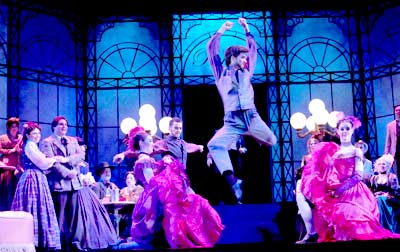
Act II is in a ballroom at Bullier’s nightclub. OSJ really shone here. The entire stage is in a glittering barn-like structure that is filled with 40 or so people. Waiters are serving and taking orders, the manager is greeting new arrivals, four can-can dancers appear and dance from time to time. Then a moving oasis appears in the crowd where Magda and Ruggero meet, become acquainted, and fall in love – all alone in a crowd. There’s a cute bit where the crowd becomes aware of them (but not vice versa), eavesdrop on their conversation with exaggerated gestures of secrecy, and then sing joyfully in approval of love. I have nothing but admiration for the person responsible for the blocking. I didn’t miss the scenery on Saturday, but it really added to Act II on Sunday.
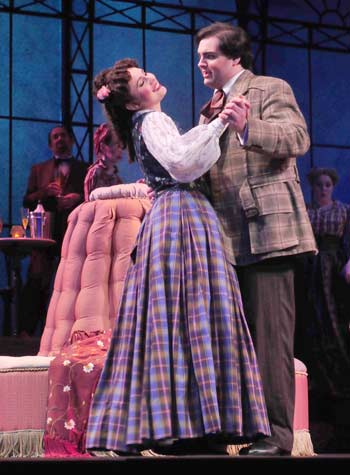
Act III is in stark contrast. Magda and Ruggero are alone on stage for most of the act except for an interlude with Prunier and Lisette. On PO’s small stage only a few pieces are necessary – more would be a distraction. OSJ did a wonderful job of reducing the large stage to the necessary intimacy by use of white wood and rose bushes.
3. Third difference, language. Otherwise reasonable people can become choleric over this issue. Traditionalists maintain that the music and original-language words were meant to go together and any change from that would be sacrilege. Modernists say that to fully appreciate opera the audience must comprehend the music, the action, and the words – therefore, if the audience knows only English, then the opera should be sung in English. In my opinion, a poor translation is worse than none at all; a good translation is the best way to enjoy opera. Donald Pippin’s translations are invariably good.
4. The final difference I’ll mention today is the Final Curtain. My pet peeve is that American audiences are programmed to start applauding when they see the first thin appearance of the curtain at the top or side of the stage. Never mind that the soprano has just begun the extended high C that she spent years training for. Never mind that the orchestra still has a full three measures to go before it reaches that final crashing chord with which the composer thinks to summarize, climax, and conclude the opera. Never mind that subscribers have spent vast sums for the right to hear all this wonderful music. No, they would rather hear the rhythmic clap of their own hands and they are more than willing to share that primitive pleasure with the rest of the audience.
I’m not really upset about this issue. I know I’m not going to change the audience. In fact, most of the friends I sit with join the applause as soon as it starts and they are not any less my friends. But I do think that directors could do more to help the audience enjoy “all” of the opera by dimming light to control the action and then quietly closing the curtain in darkness after the music has stopped and the applause has begun.
Pocket Opera resolves this problem by relying entirely on light. They don’t have a curtain! Saturday afternoon PO ended the opera perfectly. Magda sings her last soulful aria in which she explains to Ruggero that he will recover from her parting, whereas if she married him he would eventually hate her and would never recover. Ruggero sits looking at her at first and making signs of disagreement. Gradually he looks away and stares despondently at the floor. Magda finishes singing. She looks once at Ruggero, but he doesn’t look up. As the orchestra keeps playing, ever more quietly, Magda slowly walks the short distance to the wing and disappears from sight as she sings her last farewell. A few of the audience start to applaud as they do after any aria, but quickly realize that it is inappropriate. The orchestra plays its last pianissimo note; an instant’s pause; Donald drops his hands to indicate finis – it is finished. An instant of shocked silence, then the applause breaks out. It took most of the audience a few seconds to realize that this was, indeed, the end. A poignant and thoroughly satisfying ending to a beautiful opera.
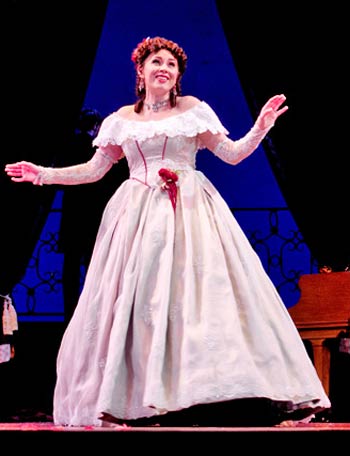
The Sunday ending began the same way. But the stage was too wide for Magda to walk all the way to the wing. Instead, she headed straight back to a sort of boardwalk and stood quietly gazing out to sea as the back stage lighting faded until she was barely visible. Beautiful. But then, before the music was finished, the edge of the damned curtain appeared at the top of the stage aperture, the applause started – the mood was broken before it had truly begun. Don’t get me started!

Wow, I’ve been going on a long time. Time to quit with good news for Bay Area residents. The Pocket Opera version of La Rondine will have a second and final performance on Sunday, May 9 at the Legion. Opera San JosÉ will present six more performances over the next two weeks, the last one being also a matinee on May 9. Half of those will use an alternate cast for the major roles. I plan to go again on Tuesday, May 4 and see how that cast compares.
LA RONDINE (the Swallow) PUCCINI
You will enjoy:
Pocket Opera: Maestro Donald Pippin, Leslie Sandefur, Elizabeth Russ, Well
Meyer, Michael Mendelsohn, Jonathan Spencer,
Opera San JosÉ: Maestro David Rohrbach with Jasmina Halimic, Jennie Litster, Alexander Boyer, J. Raymond Meyers, Silas Elash
POCKET OPERA
Florence Gould Theatre
Legion of Honor
469 Bryant Street
San Francisco, CA
415.972.8930
Photos: Cate Gerrity
OPERA SAN JOSé‰
California Theatre
2149 Paragon Dr.
San Jose, CA
408.437.4450
Photos: Pat Kirk

